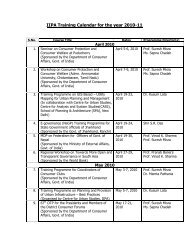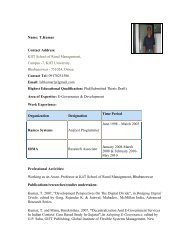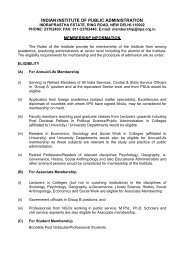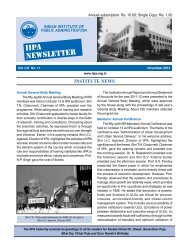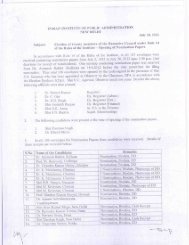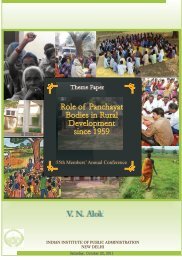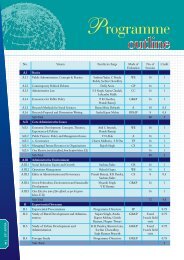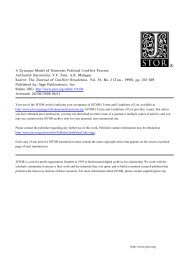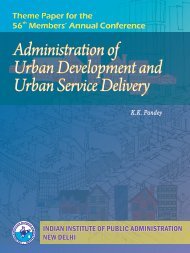Subcontracting and Economic - Indian Institute of Public Administration
Subcontracting and Economic - Indian Institute of Public Administration
Subcontracting and Economic - Indian Institute of Public Administration
You also want an ePaper? Increase the reach of your titles
YUMPU automatically turns print PDFs into web optimized ePapers that Google loves.
<strong>Subcontracting</strong> And <strong>Economic</strong> Reforms In India With Special Reference To Agro-based Industries In India<br />
3<br />
Different Forms <strong>of</strong> <strong>Subcontracting</strong><br />
The nature <strong>of</strong> the production process determines the form<br />
<strong>of</strong> subcontracting <strong>and</strong> also the extent to which the<br />
outsourcing relation develops in an industry. <strong>Subcontracting</strong><br />
is usually possible in those industries, where the<br />
production process is divisible in different stages or the<br />
final product constitutes several components <strong>and</strong> subassembling<br />
activities.<br />
On the basis <strong>of</strong> the parent firm’s behaviour, subcontracting<br />
can be classified into two broad categories. These are:<br />
• Industrial subcontracting ; <strong>and</strong><br />
• Commercial subcontracting.<br />
These two broad categories can again be classified into<br />
several subcategories, which are discussed below:<br />
Industrial <strong>Subcontracting</strong><br />
In industrial subcontracting, the parent firm purchases<br />
different components, intermediate inputs used in the final<br />
output production, or different types <strong>of</strong> assembling services<br />
from its subcontractors. The different forms <strong>of</strong> industrial<br />
subcontracting, are mentioned below:<br />
(i) Component subcontracting ;<br />
(ii) Activity subcontracting ; <strong>and</strong><br />
(iii) Assembling subcontracting.<br />
Each sub-category is described in detail.<br />
(i) Component subcontracting<br />
Component subcontracting is the most common form<br />
<strong>of</strong> the outsourcing relationship, under which the nuclear firm<br />
purchases different components <strong>and</strong> intermediate inputs<br />
required for the completion <strong>of</strong> the final outputs from the<br />
cluster <strong>of</strong> subcontractors. Component subcontracting is <strong>of</strong>ten<br />
observed in the metal industry (Nagaraj, 1984). In this type<br />
<strong>of</strong> inter-firm relationship, the financial <strong>and</strong> technological<br />
support, quality, lay out, etc. are decided by the parent firms.<br />
Since in the market, the final products are sold under the<br />
nuclear firm’s br<strong>and</strong> name, the principal firm undertakes the<br />
marketing, post-selling services, <strong>and</strong> research <strong>and</strong> development<br />
activities.<br />
(ii) Activity subcontracting<br />
Activity subcontracting generally takes place in those production<br />
processes that can be separated. In activity subcontracting,<br />
the production method is divided into several<br />
stages. The inputs are transformed through a number <strong>of</strong><br />
activities, some <strong>of</strong> which are undertaken by a cluster <strong>of</strong><br />
subcontractors, since due to various technological reasons<br />
those distinct, separate activities cannot be carried out continuously<br />
in the same premises. The parent firm organises<br />
the whole production course <strong>and</strong> sells the final product<br />
under its own br<strong>and</strong> name. This type <strong>of</strong> subcontracting is<br />
usually observed in the <strong>Indian</strong> cotton industry (Nagaraj,<br />
1984).<br />
(iii) Assembling subcontracting<br />
Assembling subcontracting is the service subcontracting,<br />
that is, the principal firm is purchasing different types <strong>of</strong><br />
assembling services from its subcontractors (Nagaraj, 1984).<br />
Mainly the parent firm outsources highly labour-intensive<br />
assembling activities to the small firm, to those who have<br />
4




